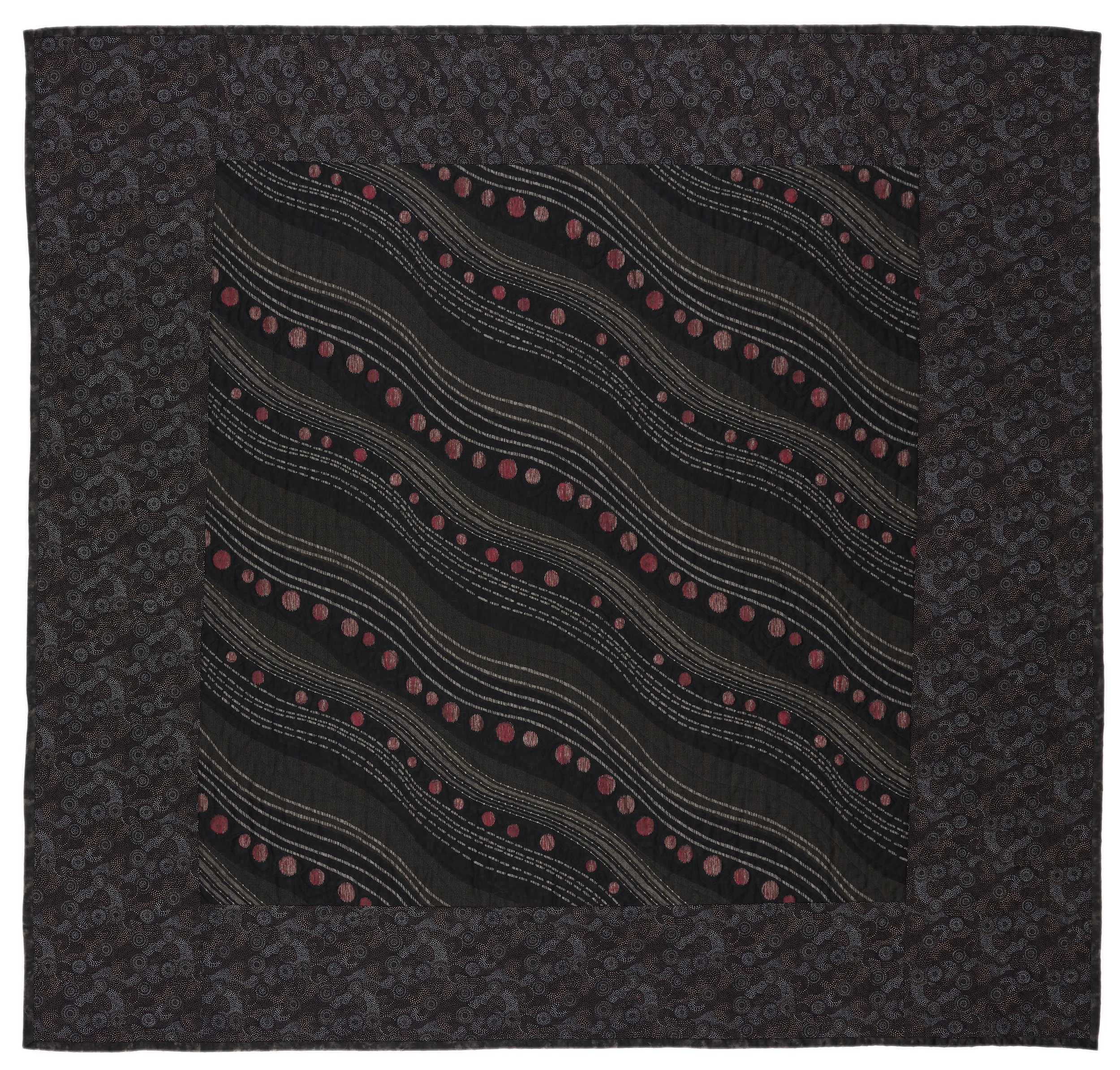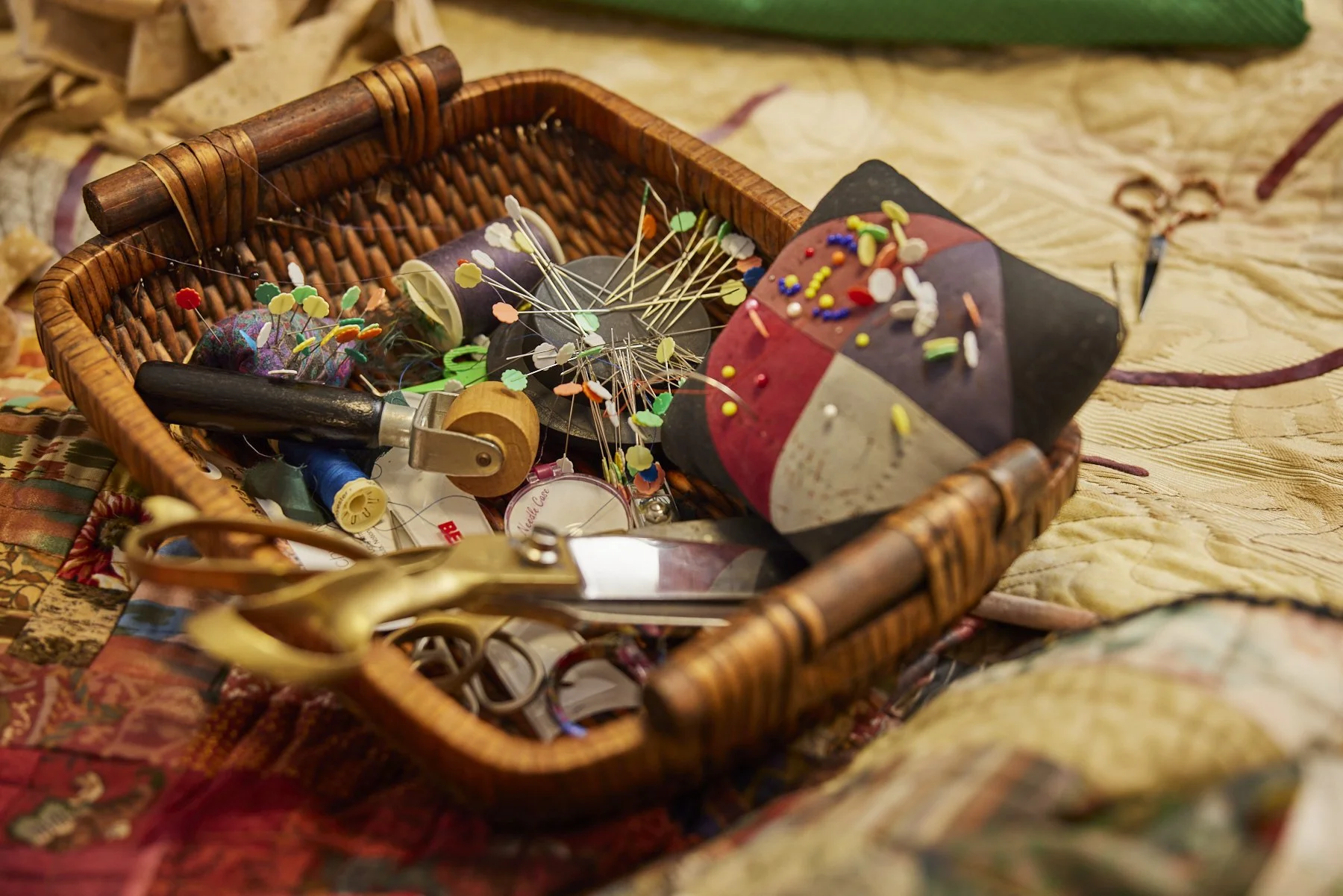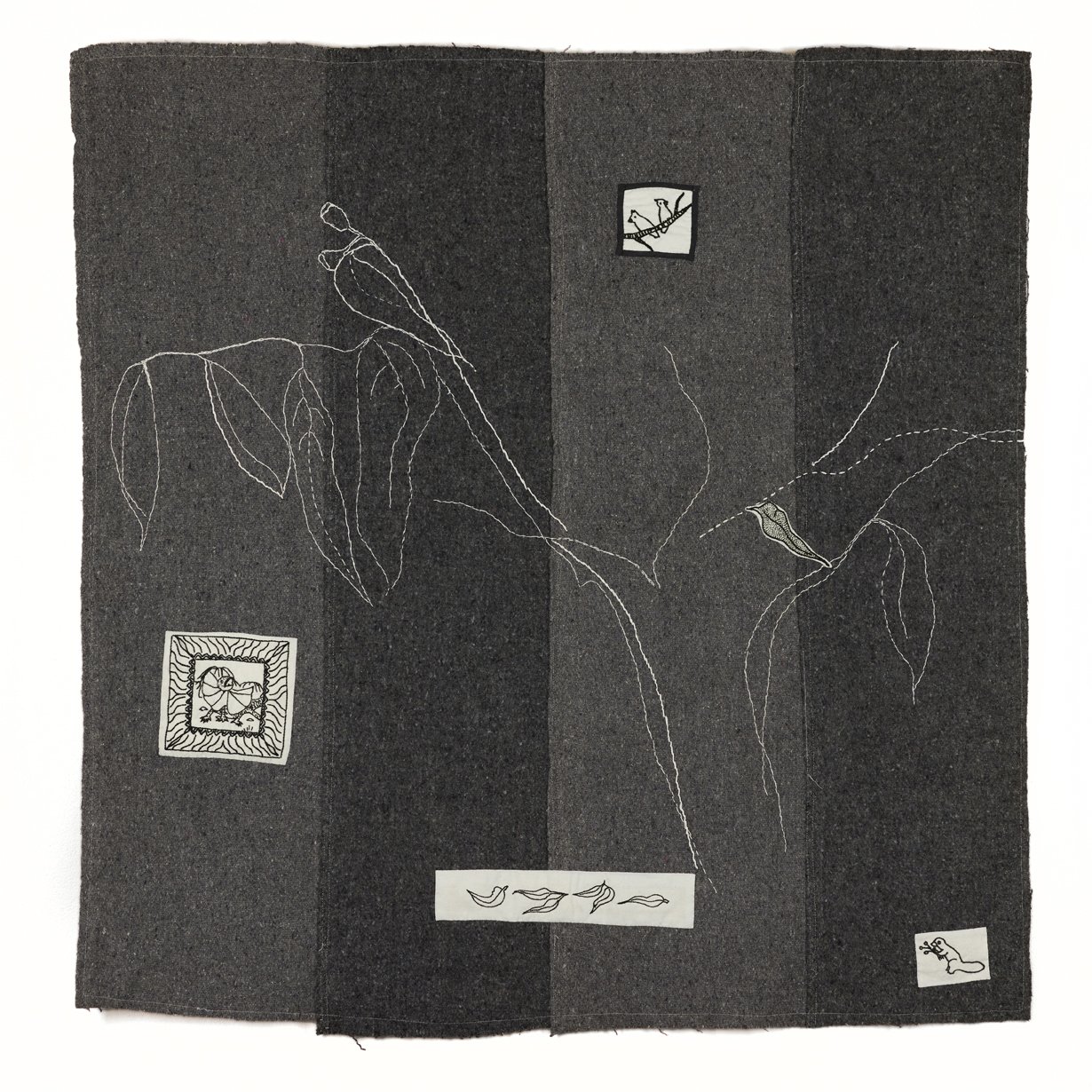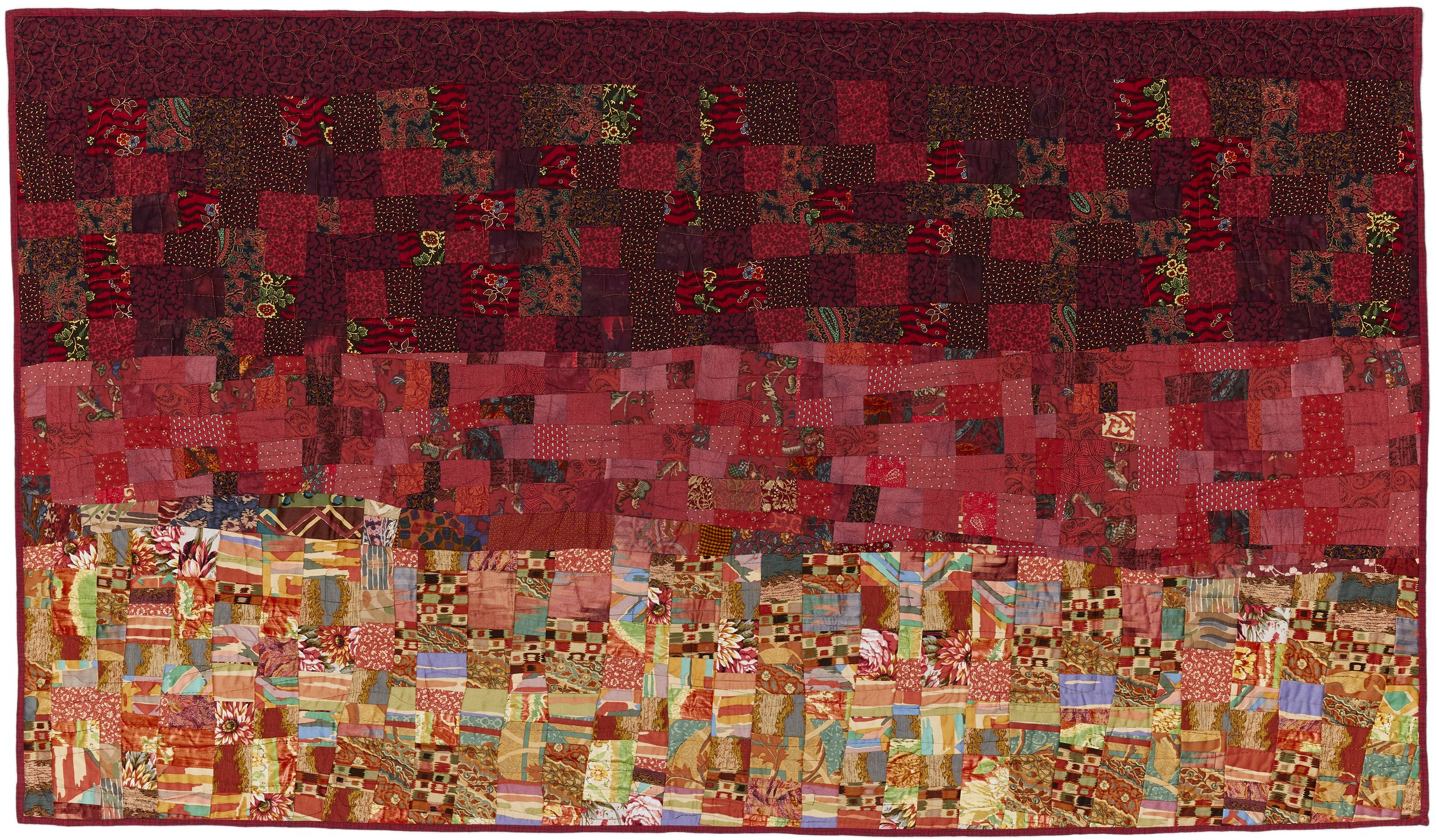Dianne Finnegan is an award-winning international textile artist, author and a pioneer in original cutting edge designs and techniques.
She has presented exhibitions, lectures and workshops around the world including London, the USA, Canada and many more.
Using her background in geomorphology, a passion for human stories, the environment, and a natural intuition for visual texture, she creates highly unique works.
204cm x 208cm (80” x 82”) Liberty and Willliam Morris cottons: Machine pieced and quilted.
The eye swirls around the circles that, on closer inspection, are composed of straight lines. No curves in the piecing.
The MacDonnell Ranges in Central Australia are the stump of one arm of a fold mountain belt, with weaker strata eroded out to form valleys interspersed with lines of ridges.
173cm x 87cm (68.11" x 34") Cotton: Machine pieced and quilted
Japanese indigo dyed cotton backed by cotton with Jimmy Pike design. A dua negri work, combining the fabrics of two countries.
126cm x 157cm Cotton, pieced by Trish Lieberman and Dianne Finnegan. Machine pieced and quilted by Finnegan.
Hand dyed fabric by Anindilyakwa Artist from Groote Eylandt. Indian backing fabric to recognise textile trade between Indonesian and India. A dua negri work.
127cm x 201cm Bush dyed wool, cotton batt, cotton. Machine pieced and quilted.
Lockdown was a kind of purification. Isolation was hard, but provided the opportunity to reassess, clarify and distil life. St John of the Cross wrote of the Dark Night of the Soul in the 16th century.
163cm x 63cm Cotton, wool batt. Machine pieced and quilted
Bush dyed linen by Candice Jaragba from Anindilyakwa Arts, Groote Eylandt. Dutch Indonesian backing fabric references centuries of trade between Malaccans and Yolngu of Arnhem land.
127cm x 189cm Bush dyed wool. Cotton batt and backing. Machine pieced and quilted.
Traditional French toiles surrounded by Japanese indigo dyed border, backed by Australian toiles including images of Sir Henry Parkes and Sister Mary MacKillop.
115cm x 166cm. Cotton. Machine pieced and quilted.
Bush dyed fabric by women from Anindilyakwa Arts, Groote Eylandt. Dutch Indonesian backing fabric references centuries of trade between Malaccans and Yolngu of Arnhem land.
123cm x 203cm Bush dyed wool. cotton batt and backing. Machine pieced and quilted.

131cm x 195cm (51.50" x 76.77") Cotton: Machine pieced and quilted. Screen-printed fabric of the border is designed by Kieren Karritpul
Aboriginal artist Kieren Karritpul’s evocative fabric design of water flowing encloses Dianne’s Regeneration, a visible reminder of the primal importance of water in the landscape.
Hand dyed with leaves, twigs etc by women from Anindilyakwa Arts, Groote Eylandt, the piece presents a planar perspective of a dry, folded mountain belt. Emerging from the background is a swirl of colour promising the wild flowers to bloom following rain. The backing shows a closeup of the desiccated soil cracking.
127cm x 189cm Bush dyed wool, cotton, wool batt, cotton backing. Machine pieced and quilted.
80cm x 155cm (31” x 60.5”) cotton, machine pieced and quilted catalogue # D05
Dusk. The everyday world is veiled, its presence obscured. Shapes emerge but details are uncertain. The overlying distorted grid holds it together, suggesting the weave of fabric. The first in a series responding to lockdown from Covid 19.
200cm x 138cm cotton, found and hand dyed, hand appliquéd, machine pieced and quilted. catalogue # D07
The parallel dunes of Central Australia seem monotonous to some but they attest to a wind directions almost consistent over 10 000 years. The bidirectional wind regime leads to the formation of occasional Y-dunes.
250cm x 149cm cotton, machine pieced and quilted. catalogue # D03
Australia is a country that is rusting, the iron moving through the rock to concentrate in the top layer in an ironstone caprock that protects the underlying weathered layers. Colour is leached out of these intensely weathered mottled then pallid zones. Plateaus, mesas and buttes result.
94cm x 165cm cotton, machine pieced and quilted. catalogue # D02
A detailed view of the ironstone caprock that protects the underlying deeply weathered strata. The distinctive stratification delimits the caprock. Throughout Australia plateaus, mesas and buttes exhibit this profile. On expansive plateaus, the profile is hidden but the cover of pellet-sized red gravel signifies the pisolitic weathering typically associated with laterisation.
68cm x 128cm cotton, hand appliquéd, machine pieced and quilted. catalogue # D06
“The Grotesque, the Weird, the Monstrous, the strange Scribblings of Nature learning how to write” Marcus Clarke. The dunes of Central Australia are calligraphic in their shapes. They are almost in alignment with wind regimes of 10,000 years ago.

164cm x 49 cm cotton, machine pieced and quilted. catalogue # D04
Iron concentrated in the top layers, leached from below, forms a protective caprock. The crumbling cliff face is in constant danger of retreat as the caprock is undermined.

167cm x 143cm cotton, machine pieced and quilted.
A collaboration with composer Keyna Wilkins and violinist Airena Nakamura. I commissioned Keyna to write a piece of music on the theme of the magpie to celebrate my 70th birthday. She based the music on the song of the magpie and the Aboriginal story of how magpies lifted the shroud that blanketed the earth, revealing the sun. My quilt is a response to the music and is the third in a series responding to the lockdown from Covid 19.

100cm x 198cm (39.5” x 78”) Cotton, shibori, indigo dyed: Machine pieced and quilted
Ai is the Japanese word for indigo. It is also homophonous with the word for love. The raised texture of the design and and the slightly unpredictable variations are the result of the binding technique. This gives vitality and makes each fabric unique.

A dua negri work, combining the fabrics of two countries. Japanese and aboriginal fabric.
155cm x 146cm Cottons. Machine pieced and quilted

186cm x 175cm Japanese indigo dyed cotton. Machine pieced and quilted.
The layout is based on a Japanese textile design, the choice of fabrics determined by collecting trips to Japan. The many symbols confer good life on the recipient. Ai is the Japanese word for indigo; it is homophonous with the word for love.

110cm x 210.5cm (43” x 83”) Indigo dyed cottons: Machine piecing and quilting.
Ai is the Japanese name for indigo, also homophonous with the word for love. Extending from the Japanese indigo pattern, the desire lines are unstructured paths forged by cattle between water holes. The paths are not regimented, they respond informally to the landscape.

Textile design from the Arts Centre Bula’Bula in Ramingining Arnhem Land. The backing cotton is from the textile factory Faso Fani in Burkina Faso before it was abruptly shut down. A dua negri work.
152cm x 178cm Cotton screen printed. Machine pieced and quilted.

109cm x 151cm (43” x 59.5”) Indigo dyed cottons. Old and new Japanese and hand dyed cottons: Machine pieced and quilted.
Ai is the Japanese name for indigo. It is also homophonous with the word for love. Bamboo is considered good luck, a symbol of prosperity, purity and innocence. Take is homophonous with warrior and bravery and sounds like the words for tall and hawk. The quilt is full of auspicious symbols for the owner.































202cm x 195cm (79.53" x 76.77") Cotton: Machine pieced and quilted.
An I Spy quilt, animals, birds and other exotica inhabit the surface of this quilt.
Artwork’s page